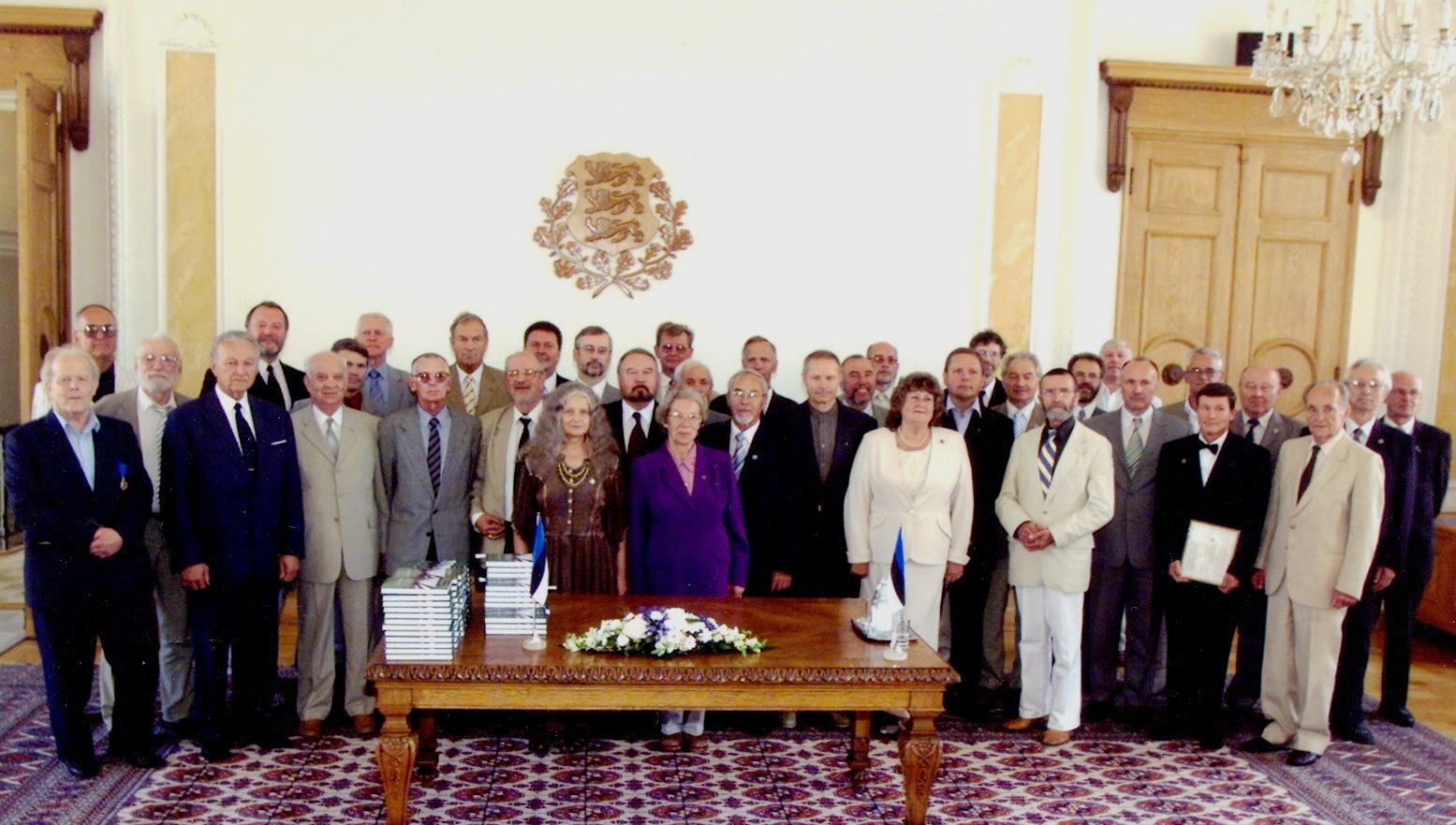|
Tõnu Anton
Tõnu Anton (born 26 April 1953, in Pärnu) is an Estonian former politician and judge, most notable for being a voter for the Estonian restoration of Independence. Biography He graduated from Pärnu 1st Secondary School in 1971, and in 1976 from the Faculty of Law of the University of Tartu. After he graduated and until 1990, he worked at the Tartu City RSN Executive Committee. In addition, he was Deputy Director of Tartu Commercial Bank. He was developing a new electoral law of the Supreme Council following democratic principles, adopted by the XI Supreme Council on November 17, 1989. During the Estonian Supreme Soviet election in 1990, Anton turned was elected as a member of the 1990s incarnation of the Vaba Eesti party and a citizens' initiative to nominate a candidate. In the Supreme Council, he represented the Popular Front of Estonia and the Social Democratic Party (until June 1991) and became chair of the Legal Affairs Committee. He was a part of the Constitutional Asse ... [...More Info...] [...Related Items...] OR: [Wikipedia] [Google] [Baidu] |
Pärnu
Pärnu () is the fourth-largest city in Estonia. Situated in southwest Estonia, Pärnu is located south of the Estonian capital, Tallinn, and west of Estonia's second-largest city, Tartu. The city sits off the coast of Pärnu Bay, an inlet of the Gulf of Riga, which is a part of the Baltic Sea. In the city, the Pärnu River drains into the Gulf of Riga. Pärnu is a popular summer Tourism, holiday resort town among Estonians with many hotels, restaurants and large beaches. The city is served by Pärnu Airport. History Pärnu or Old Pärnu (, , ), which was founded by the bishop of Bishopric of Ösel–Wiek, Ösel–Wiek , suffered heavily under pressure of the concurrent town, and was finally destroyed . Another town, Embeke (later , ) was founded by the Livonian Order, who began building an Ordensburg nearby in 1265. The latter town, then known by the German name of , was a member of the Hanseatic League and an important ice-free harbor for Livonia. The Polish–Lithuanian ... [...More Info...] [...Related Items...] OR: [Wikipedia] [Google] [Baidu] |
Order Of The National Coat Of Arms
The Order of the National Coat of Arms (, ) was instituted by Konstantin Päts on 7 October 1936 to commemorate 24 February 1918, the day on which Estonian independence was declared. The Order of the National Coat of Arms is bestowed only on Estonian citizens, as a decoration of the highest class for services rendered to the state. Classes The Order of the National Coat of Arms comprises six classes: * One special class – the Collar of the Order of the National Coat of Arms; * Five basic classes – 1st, 2nd, 3rd, 4th and 5th class. The greater national coat of arms as part of the decorations of all the classes of the Order of the National Coat of Arms, goldplated on both sides, bears on its reverse the embossed date "24. II 1918". The colour tone of the blue moiré ribands belonging to the decorations of all the classes of the Order of the National Coat of Arms is determined according to the international PANTONE colour-table as 285 C. Collar The collar of the Order of the ... [...More Info...] [...Related Items...] OR: [Wikipedia] [Google] [Baidu] |
Estonian Jurists
Estonian may refer to: * Something of, from, or related to Estonia, a country in the Baltic region in northern Europe * Estonians, people from Estonia, or of Estonian descent * Estonian language * Estonian cuisine * Estonian culture See also * * Estonia (other) * Languages of Estonia * List of Estonians This is a list of notable people from Estonia, or of Estonian ancestry. Architects * Andres Alver (born 1953) * Dmitri Bruns (1929–2020) * Karl Burman (1882–1965) * Eugen Habermann (1884–1944) * Georg Hellat (1870–1943) * Otto Pius Hip ... {{Disambiguation Language and nationality disambiguation pages ... [...More Info...] [...Related Items...] OR: [Wikipedia] [Google] [Baidu] |
People From Pärnu
The term "the people" refers to the public or common mass of people of a polity. As such it is a concept of human rights law, international law as well as constitutional law, particularly used for claims of popular sovereignty. In contrast, a people is any plurality of persons considered as a whole. Used in politics and law, the term "a people" refers to the collective or community of an ethnic group or nation. Concepts Legal Chapter One, Article One of the Charter of the United Nations states that "peoples" have the right to self-determination. Though the mere status as peoples and the right to self-determination, as for example in the case of Indigenous peoples (''peoples'', as in all groups of indigenous people, not merely all indigenous persons as in ''indigenous people''), does not automatically provide for independent sovereignty and therefore secession. Indeed, judge Ivor Jennings identified the inherent problems in the right of "peoples" to self-determination, as i ... [...More Info...] [...Related Items...] OR: [Wikipedia] [Google] [Baidu] |
Living People
Purpose: Because living persons may suffer personal harm from inappropriate information, we should watch their articles carefully. By adding an article to this category, it marks them with a notice about sources whenever someone tries to edit them, to remind them of WP:BLP (biographies of living persons) policy that these articles must maintain a neutral point of view, maintain factual accuracy, and be properly sourced. Recent changes to these articles are listed on Special:RecentChangesLinked/Living people. Organization: This category should not be sub-categorized. Entries are generally sorted by family name In many societies, a surname, family name, or last name is the mostly hereditary portion of one's personal name that indicates one's family. It is typically combined with a given name to form the full name of a person, although several give .... Maintenance: Individuals of advanced age (over 90), for whom there has been no new documentation in the last ten ... [...More Info...] [...Related Items...] OR: [Wikipedia] [Google] [Baidu] |
1953 Births
Events January * January 6 – The Asian Socialist Conference opens in Rangoon, Burma. * January 12 – Estonian émigrés found a government-in-exile in Oslo. * January 14 ** Marshal Josip Broz Tito is chosen President of Yugoslavia. ** The CIA-sponsored Robertson Panel first meets to discuss the UFO phenomenon. * January 15 ** Georg Dertinger, foreign minister of East Germany, is arrested for spying. ** British security forces in West Germany arrest 7 members of the Naumann Circle, a clandestine Neo-Nazi organization. * January 19 – 71.1% of all television sets in the United States are tuned into '' I Love Lucy'', to watch Lucy give birth to Little Ricky, which is more people than those who tune into Dwight Eisenhower's inauguration the next day. This record is never broken. * January 24 ** Mau Mau Uprising: Rebels in Kenya kill the Ruck family (father, mother, and six-year-old son). ** Leader of East Germany Walter Ulbricht announces that ... [...More Info...] [...Related Items...] OR: [Wikipedia] [Google] [Baidu] |
Order Of The White Star
The Order of the White Star (; ) was instituted in 1936. The Order of the White Star is bestowed on Estonian citizens and foreigners to give recognition for services rendered to the Estonian state. Design Classes The Order of the White Star comprises one special collar class, five basic classes, and one medal: * Special class: Collar of the Order. It is a golden necklet that has smaller Stars in its design all around it. * The five main classes: ** First Class – It has two different types, the male version and the female version. The male version of the Order of the White Star has wider ribbons than the female class. ** Second Class – It has two different types, the male version and the female version. The male version of the Order of the White Star is worn around the neck, female recipients wear the insignia mounted on a bow on the left chest. ** Third Class – It has two different types, the male version and the female version. The male version of the Order of the Whi ... [...More Info...] [...Related Items...] OR: [Wikipedia] [Google] [Baidu] |
Estonian Restoration Of Independence
Estonian Restoration of Independence, legally defined as the Restoration of the Republic of Estonia, was proclaimed on 20 August 1991. On that day at 23:02 local time, the Supreme Council of the Republic of Estonia, in agreement with the Estonian Committee (the executive organ of the Congress of Estonia), declared the illegal Soviet occupation and annexation of the country terminated, and proclaimed the full restoration of the independence of Estonia. 1990 On 30 March 1990, the Supreme Soviet of the Estonian SSR adopted a resolution on the state status of Estonia. The resolution declared that the Soviet occupation of 17 June 1940 did not ''de jure'' interrupt the existence of the Republic of Estonia, the Supreme Soviet declared the state power of the Estonian SSR illegal from the moment of its establishment and proclaimed the start of a transitional period to full ''de facto'' independence pending the restoration of the constitutional bodies of state power of the Republic ... [...More Info...] [...Related Items...] OR: [Wikipedia] [Google] [Baidu] |
Ülle Madise
Ülle Madise (née Anton; born 11 December 1974) is an Estonian lawyer who has served as Chancellor of Justice since 2015. Madise is the daughter of former member of the Supreme Court of Estonia Tõnu Anton. In December 2021 Madise was re-appointed by the Riigikogu for a second term as Chancellor of Justice. Education Madise graduated in 1993 from Tartu Descartes School and in 1998 received a ''cum laude'' from the University of Tartu, Faculty of Law. Biography Her father is Tõnu Anton, a former member of the Supreme Court of Estonia and signatory of the ratification of the Estonian restoration of Independence. Ülle Madise is also a professor of constitutional law at the University of Tartu. Madise is the daughter of former member of the Supreme Court of Estonia Tõnu Anton. In December 2021 Madise was re-appointed by the Riigikogu for a second term as Chancellor of Justice.Turovski, MarcusRiigikogu appoints Ülle Madise for second justice chancellor term.''ERR News.'' ... [...More Info...] [...Related Items...] OR: [Wikipedia] [Google] [Baidu] |
Chancellor Of Justice (Estonia)
The Estonian Chancellor of Justice ''(Estonian: Õiguskantsler)'' is an independent supervisor of the basic principles of the Constitution of Estonia and the protector of individual rights. The institution seeks to ensure that authorities fulfil the obligations deriving from the principles of the rule of law and protection of human and social rights, human dignity, freedom, equality and democracy. The Chancellor of Justice is appointed to office by the Riigikogu on the proposal of the President. History The institution of the Chancellor of Justice was originally established by the 1938 Constitution but ceased to operate in Estonia during the Soviet era. Re-established in 1993, it combines the function of the general body of petition and the guardian of constitutionality. Such a combined competence is unique internationally. The institution is independent of the legislative, executive or judicial powers, and reviews the application of the legislative and executive powers of the s ... [...More Info...] [...Related Items...] OR: [Wikipedia] [Google] [Baidu] |


